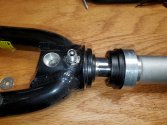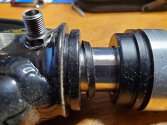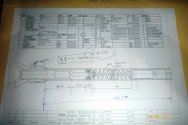Hey, everyone,
Long-time V1 rider. I have two of them, with upgrades to wheels, tires, brakes, gearing, rear shocks, etc.
I just realized that one of them has a headset shock that works great, while the other one's front shock doesn't move at all. I've read through the old posts, even the one that suggests fixing it wouldn't make a difference. But I ride both the bikes and can feel a difference in the ride on the bike that has a working front shock. And I'm retired and at the moment have not much better to do that put some time into tinkering with it---provided I can get answers or advice on the following questions!
1. Is working on the headset and shock area of the V1 something a technically competent regular person can do? I am not a trained bike mechanic, but I have done the basic maintenance and repairs on my bikes in the past, and I can follow instructions.
2. Can this kind of tinkering be done without specialized or expensive tools?
3. What brand and/or kind of shock is on the V1, and are there service bulletins, manuals, or youtube videos to learn from?
Thanks to whomever can help with this!
David Hardt
Roxboro, NC
Long-time V1 rider. I have two of them, with upgrades to wheels, tires, brakes, gearing, rear shocks, etc.
I just realized that one of them has a headset shock that works great, while the other one's front shock doesn't move at all. I've read through the old posts, even the one that suggests fixing it wouldn't make a difference. But I ride both the bikes and can feel a difference in the ride on the bike that has a working front shock. And I'm retired and at the moment have not much better to do that put some time into tinkering with it---provided I can get answers or advice on the following questions!
1. Is working on the headset and shock area of the V1 something a technically competent regular person can do? I am not a trained bike mechanic, but I have done the basic maintenance and repairs on my bikes in the past, and I can follow instructions.
2. Can this kind of tinkering be done without specialized or expensive tools?
3. What brand and/or kind of shock is on the V1, and are there service bulletins, manuals, or youtube videos to learn from?
Thanks to whomever can help with this!
David Hardt
Roxboro, NC





